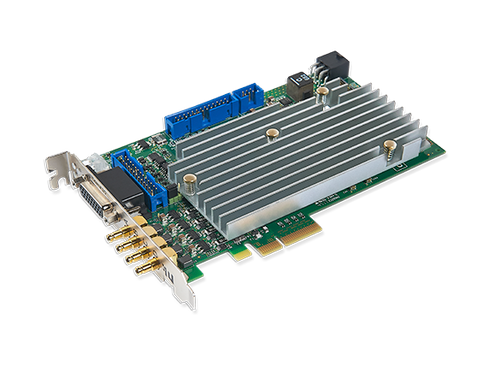Product Description
Coaxlink QSFP+
Four-connection CoaXPress-over-Fiber frame grabber
AT A GLANCE
- One QSFP+ port compliant with 40 Gbps optical modules
- 5,000 MB/s camera bandwidth
- PCIe 3.0 (Gen 3) x8 bus: 6,700 MB/s bus bandwidth
- Feature-rich set of 20 digital I/O lines
- Extensive camera control functions
- Memento Event Logging Tool
- Compatible with CustomLogic: Your own FPGA logic
See the DATA SHEET and FAQ's about CoaXPress-over-Fiber, and for additional Benefits to the list below
Benefits
What is CoaXPress-over-Fiber?
CoaXPress-over-Fiber is a light but significant extension of the existing CoaXPress specification to support transport over fiber optics.
CoaXPress (CXP) is the de-facto standard for high-bandwidth computer vision applications. CoaXPress 2.1, the latest version of the specification, specifies the CXP-12 speed, a 12.5 Gbps (Gigabit per second) connection over a coaxial copper cable. As link aggregation is common with CoaXPress, bandwidths of 50 Gbps (12.5 x 4) are easily achievable with four CXP-12 connections. CoaXPress-over-Fiber has been designed as an add-on to the CoaXPress specification. It provides a way to run the CoaXPress protocol, as it is, unmodified, over a standard Ethernet connection, including fiber optics. As such, CoaXPress-over-Fiber uses standard electronics, connectors and cables designed for Ethernet, but the protocol is CoaXPress, not Ethernet, not GigE Vision.
Read more about CoaXPress-over-Fiber on our FAQ's page.
PCIe 3.0 (Gen 3) x8 bus
• 7,800 MB/s peak bus bandwidth
• 6,700 MB/s sustained bus bandwidth Acquire images from the fastest and highest resolution cameras
• Highest data acquisition rate in the industry
• Up to 5,000 MB/s bandwidth from camera to host PC memory
What are the pros and cons of using fiber optics?
Pros
• First and foremost, cable length is not an issue anymore as fiber connectivity is basically not limited in length
• Fiber optics provide more bandwidth, as connectivity at 10 and 25 Gbps per fiber is standard today and widely used in data centers.
• Fiber optics are immune to electrical noise, which will be a significant advantage on the production floor and in some medical applications.
• Fiber optics are lighter and smaller in size than the equivalent copper cabling, making it appropriate for applications where this characteristic is essential, like in aircrafts or vehicles.
Cons
• There is no "power over fiber". As signals in fiber optics are transmitted using light, there is no way to transfer power over fiber optics and devices such as cameras must be powered separately.


















